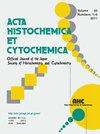七氟醚和异丙酚激活脑区的鉴定及基因表达的区域变化
IF 1.8
4区 生物学
Q4 CELL BIOLOGY
引用次数: 2
摘要
全身麻醉剂根据其作用机制有不同的疗效和副作用发生率。然而,麻醉剂的详细比较研究尚不完整。在这项研究中,确定了七氟醚和丙泊酚的靶脑区域和这些脑区域的基因表达变化,以了解导致麻醉剂之间差异的机制。用七氟醚或丙泊酚麻醉大鼠1小时,并通过免疫组织化学和c-Fos原位杂交检测麻醉诱导的神经元活动变化的大脑区域。在确定的靶脑区域中,对激光显微切割样本的缰核、孤立核和前庭内侧核进行了基因表达分析。七氟醚和丙泊酚改变的基因是不同的,包括与术后恶心呕吐和苏醒激动发生率有关的基因,如Egr1和Gad2。GO富集分析表明,改变的基因倾向于均匀分布在所有功能类别中。本研究中七氟醚和丙泊酚靶脑区域的详细图谱和诱导的基因表达变化将为分析每种麻醉剂的效果和不良事件的风险提供基础。本文章由计算机程序翻译,如有差异,请以英文原文为准。
Identification of Brain Regions Activated by Sevoflurane and Propofol and Regional Changes in Gene Expression
General anesthetics have different efficacies and side effect incidences based on their mechanism of action. However, detailed comparative studies of anesthetics are incomplete. In this study, target brain regions and gene expression changes in these brain regions were determined for sevoflurane and propofol to understand the mechanisms that cause differences among anesthetics. Rats were anesthetized with sevoflurane or propofol for 1 hr, and brain regions with anesthesia-induced changes in neuronal activity were examined by immunohistochemistry and in situ hybridization for c-Fos. Among the identified target brain regions, gene expression analysis was performed in the habenula, the solitary nucleus and the medial vestibular nucleus from laser microdissected samples. Genes altered by sevoflurane and propofol were different and included genes involved in the incidence of postoperative nausea and vomiting and emergence agitation, such as Egr1 and Gad2. GO enrichment analysis showed that the altered genes tended to be evenly distributed in all functional category. The detailed profiles of target brain regions and induced gene expression changes of sevoflurane and propofol in this study will provide a basis for analyzing the effects of each anesthetic agent and the risk of adverse events.
求助全文
通过发布文献求助,成功后即可免费获取论文全文。
去求助
来源期刊

Acta Histochemica Et Cytochemica
生物-细胞生物学
CiteScore
3.50
自引率
8.30%
发文量
17
审稿时长
>12 weeks
期刊介绍:
Acta Histochemica et Cytochemica is the official online journal of the Japan Society of Histochemistry and Cytochemistry. It is intended primarily for rapid publication of concise, original articles in the fields of histochemistry and cytochemistry. Manuscripts oriented towards methodological subjects that contain significant technical advances in these fields are also welcome. Manuscripts in English are accepted from investigators in any country, whether or not they are members of the Japan Society of Histochemistry and Cytochemistry. Manuscripts should be original work that has not been previously published and is not being considered for publication elsewhere, with the exception of abstracts. Manuscripts with essentially the same content as a paper that has been published or accepted, or is under consideration for publication, will not be considered. All submitted papers will be peer-reviewed by at least two referees selected by an appropriate Associate Editor. Acceptance is based on scientific significance, originality, and clarity. When required, a revised manuscript should be submitted within 3 months, otherwise it will be considered to be a new submission. The Editor-in-Chief will make all final decisions regarding acceptance.
 求助内容:
求助内容: 应助结果提醒方式:
应助结果提醒方式:


